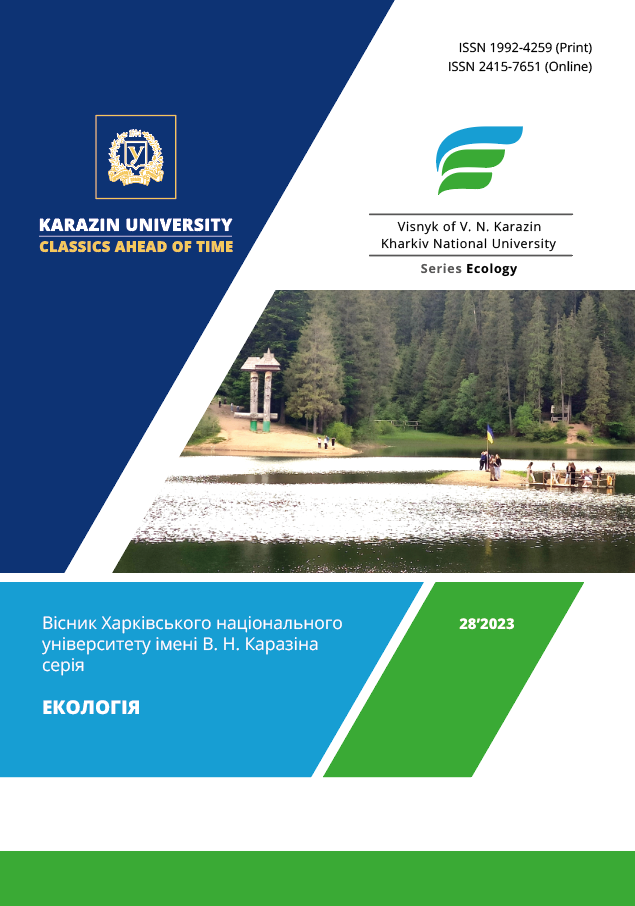Features of the of the Katowice city green infrastructure: problems and prospects
Abstract
Purpose. To assess the provision of green infrastructure in the city of Katowice (Poland) based on the analysis of the peculiarities of its formation and spatial distribution on the territory of urban landscapes.
Methods: Historical (study of the historical path of the formation of Katowice as a modern green city), mathematical and statistical for calculating the green index of the provision of the population with green infrastructure and methods of systematization and generalization.
Results. Katowice is a city in southern Poland, which was formed in the middle of the 19th century as a result of the development of the coal industry in the Silesian region. It now has an area of 164.73 km2 and a population of 290 thousand people. In order to level the negative consequences of the industrial depletion of urban landscapes in the city, the development of green infrastructure has been introduced, which currently makes up 42% of the city's area, which is not evenly distributed. It has been established that green infrastructure has a significant positive impact on the quality of life of residents of urbanized areas of the city of Katowice. Among the districts, Podlasie stands out - more than 300 m2/person. Murky and Paderevsky-Mukhovets - more than 250 m2/person. Shopenice-Burovets, and Brynow - Os. Zgrzebnska - more than 100 m2/person and Domb, Zarzeche and Dombruvka Mala - from 50 to 100 m2/person. These areas have a sufficient level of provision of green infrastructure for the population according to WHO norms (50 m2). But Zavodze, Zelenska and Os districts. Tysenklech (ZI less than 10 m2/person) need to take measures to increase the provision of green infrastructure to the population.
Conclusions. On the basis of the calculation of the Green Index, areas that meet greening standards and areas that require the use of the latest green infrastructure development technologies (installation of vertical gardens and greening of roofs, etc.) are determined.
Downloads
References
Maksymenko, N., Shpakivska, І., Burchenko, S., & Utkina, K. (2022). Green Infrastructure in Lviv - example of park zones. Acta Horticulturae et Regiotecturae. Slovak University of Agriculture in Nitra. 25, (1): 37–43. https://doi.org/10.2478/ahr-2022-0005
Maksymenko, N. V., Gololobova, O. O., Koval, I. M., & Kalynovskyi, O. I. (2021). Monitoring of the Condition of Green Plantations in Shevchenkivskyi District of Kharkiv (on The Example of Bittle Chestnut (Aesculus Hippocastanum L.). Man and Environment. Issues of Neoecology, 36, 56-71. https://doi.org/10.26565/1992-4224-2021-36-05
Maksymenko, N., Sonko, S., Skryhan, H., Burchenko, S., & Gladkiy, A. (2021). Green infrastructure of post-USSR cities for prevention of noise pollution. Proceedings of the IV International Scientific Congress: Society of Ambient Intelligence – 2021 (ISCSAI 2021). (Kryvyi Rih, Ukraine, 2021, April 12–16,). 100. https://doi.org/10.1051/shsconf/202110005004
Capra, C. F. (2016). The Smart City and its citizens: Governance and citizen participation in Amsterdam Smart City. Int. J. E-Plan. Res., (5), 20–38.
Maksymenko, N., Burchenko, S., Utkina, K., & Buhakova, M. (2021). Influence of green infrastructure objects for quality of surface runoff (on the example of green roofs in Kharkiv). Visnyk of V. N. Karazin Kharkiv National University, Series "Geology. Geography. Ecology;, (55), 274-284. https://doi.org/10.26565/2410-7360-2021-55-20)
Eskelinen, T. (2021). Interpreting the Sustainable Development Goals through the Perspectives of Utopia and Governance. Forum Dev. Stud. (48), 179–197. https://doi.org/10.1080/08039410.2020.1867889
Paszkowski, Z. W. (2014). Ideal Future City in Relation to Urban Tendencies in Poland. Technical Transactions. Architecture. 159–177.
Biuletyn Informacji Publicznej. Urząd Miasta Katowice. (2023, May 02). Retrieved from https://bip.katowice.eu/Strony/default.aspx?menu=562&menu=562
Industrial Legacy. (2023, May 04).: Retrieved from https://urbantransitions.org/portfolio/katowice-poland/
Is Katowice Better Than Kraków? 9 Reasons Why Katowice Is a Great City For Living (And Exploring)/ (2023, May 06). Retrieved from https://wellcome-home.com/blog/is-katowice-better-than-krakow–9reasons-why-katowice-is-a-great-city-for-living-and-exploring/
Museums instead of mines. How Katowice in Poland was turned into a green tourism city: website. (2023, May 05). Retrieved from https://www.rbc.ua/rus/travel/muzei-shaht-katovitse-polshe-prevratili-zelenyy-661783105.html
Planning «the Future of the City» or Imagining «the City of the Future»? In Search of Sustainable Urban Utopianism in Katowice. (2023, May 05). Retrieved from https://www.mdpi.com/2071–1050/14/18/11572
Draft Law of Ukraine "On green spaces of cities and other settlements". Retrieved from http://w1.c1.rada.gov.ua/pls/zweb2/webproc41?Pf3511=55455
Aleksandrova, D.O., Maksymenko, N. V., & Cherkashyna, N. I. (2023). Dіstribution of Green Infrastructure by districts of the city of Katowice (Polland). Ecology is a priority: theses of the All-Ukrainian English-speaking student conference (Kharkiv, April 19, 2023). Kharkiv: V. N. Karazin KhNU, P. 7-9. Retrieved from https://ecology.karazin.ua/wp-content/uploads/2023/04/ecology-is-a-a-priority-zbirka-2023-final.pdf
Grossi, G., & Pianezzi, D. (2017). Smart cities: Utopia or neoliberal ideology. Cities, (69), 79–85. https://doi.org/10.1016/j.cities.2017.07.012
Copyright (c) 2023 Maksymenko N. V., Titenko G. V., Aleksandrova D. O.

This work is licensed under a Creative Commons Attribution 4.0 International License.
Authors who publish with this journal agree to the following terms:
- Authors retain copyright and grant the journal right of first publication of this work under the terms of a license Creative Commons Attribution License 4.0 International (CC BY 4.0).
- Authors are able to enter into separate, additional contractual arrangements for the non-exclusive distribution of the journal's published version of the work (e.g., post it to an institutional repository or publish it in a book), with an acknowledgement of its initial publication in this journal.
- Authors are permitted and encouraged to post their work online (e.g., in institutional repositories or on their website) prior to and during the submission process, as it can lead to productive exchanges, as well as earlier and greater citation of published work.





